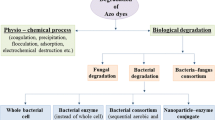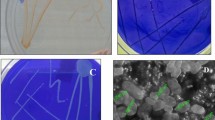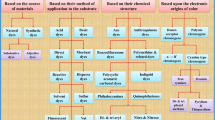Abstract
This study deals the biodegradation of the major color containing compounds extracted from distillery wastewater (DWW) by an aerobic bacterial consortium comprising Bacillus licheniformis (DQ79010), Bacillus sp. (DQ779011) and Alcaligenes sp. (DQ779012) and characterization of metabolic products. The degradation of color containing compounds by bacteria was studied by using the different carbon and nitrogen sources at different environmental conditions. Results revealed that the bacterial consortium was efficient for 70% color removal in presence of glucose (1.0%) and peptone (0.1%) at pH 7.0 and temperature 37°C. The HPLC analysis of control and bacterial degraded samples has shown the reduction in peak area as well as shifting of peaks compared to control indicating the bacterial degradation as well as transformation of color containing compounds from DWW. The comparative LC–MS–MS and other spectrophotometric analysis has shown the presence of dihydroxyconiferyl alcohol, 2, 2′-bifuran-5-carboxylic acid, 2-nitroacetophenone, p-chloroanisol, 2, 3-dimethyl-pyrazine, 2-methylhexane, methylbenzene, 2, 3-dihydro-5-methylfuran, 3-pyrroline, and acetic acid in control samples that were biodegraded and biotransformed into 2-nitroacetophenone, p-chloroanisol, 2, 2′-bifuran, indole, 2-methylhexane, and 2, 3-dihydro-5-methylfuran by bacterial consortium. In this study, it was observed that most of the compounds detected in control samples were diminished from the bacterial degraded samples and compounds 2, 2′-bifuran and indole with molecular weight 134 and 117 were produced as new metabolites during the bacterial degradation of color containing compounds from DWW.





Similar content being viewed by others
References
Bharagava RN, Chandra R, Rai V (2008) Phytoextraction of trace elements and physiological changes in Indian mustard plants (Brassica nigra L.) grown in post methanated distillery effluent (PMDE) irrigated soil. Biores Technol 99:8316–8324
Bharagava RN, Chandra R, Rai V (2009) Isolation and characterization of aerobic bacteria capable of the degradation of synthetic and natural melanoidins from distillery wastewater. World J Microbiol Biotechnol 25:737–744
Boer CG, Obici L, D’Souza CGM, Peralta RM (2006) Purification and some properties of Mn peroxidase from Lentinula edodes. Process Biochem 41:1203–1207
Cammerer B, Kroh LW (1995) Investigation of the influence of reaction conditions on the elementary composition of melanoidins. Food Chem 53:55–59
Chandra R, Pandey PK (2001) Decolorization of anaerobically treated distillery wastewater by activated charcoal adsorption method. Ind J Environ Prot 2:132–134
Chandra R, Singh H (1999) Chemical decolorization of anaerobically treated distillery wastewater. Ind J Environ Prot 19(11):833–837
Chandra R, Bharagava RN, Rai V (2008) Melanoidins as major colorant in sugarcane molasses based distillery wastewater and its degradation. Biores Technol 99:4648–4660
CPCB (2003) Charter on corporate responsibility for environmental protection. Workshop organized at Mumbai by MPCB on 03.01.2003. http://cpcb.nic.in//Charter/charter5.htm
Hofmann T (1998) Studies on melanoidin-type colorants generated from the Maillard reaction of protein-bound lysine and furan-2-carboxaldehyde-chemical characterization of a red colored domain. Z Lebensm Unters Forsch 206:251–258
Kalavathi DF, Uma L, Subramanian G (2001) Degradation and metabolization of the pigment-melanoidin in distillery wastewater by the marine cyanobacterium Oscillatoria boryana BDU 92181. Enzyme Microbiol Technol 29:246–251
Kim SB, Hayase F, Kato H (1985) Decolorization and degradation products of melanoidins on ozonolysis. Agric Biol Chem 49:785–792
Kumar P, Chandra R (2006) Decolorization and detoxification of synthetic molasses melanoidins by individual and mixed cultures of Bacillus sp. Biores Technol 7:2096–2102
Kumar V, Wati L, Nigam P, Banat IM, MacMullan G, Singh D, Marchant R (1997) Microbial decolorization and bioremediation of anaerobically digested molasses spent wash wastewater by aerobic bacterial culture. Microbios 89:81–90
Mahimaraja S, Bolan NS (2004) Problems and prospects of agricultural use of distillery spent wash in India. 3rd Australian New Zealand Soils Conference. 5–9 December’2004. University of Sydney, Australia
Migo VP, Del Rosario EJ, Matsumura M (1997) Flocculation of melanoidins induced by inorganic ions. J Ferment Bioeng 83:287–291
Mohana S, Desai C, Madamwar D (2007) Biodegradation and decolorization of anaerobically treated distillery spentwash by a novel bacterial consortium. Biores Technol 98:333–339
Ohmomo S, Itoh N, Wantanabe Y, Kaneko Y, Tozawa Y, Udea K (1985) Continuous decolorization of molasses wastewater with mycelia of Coriolus versicolor Ps4a. Agric Biol Chem 49:2551–2555
Plavsic M, Cosovic B, Lee C (2006) Copper complexing properties of melanoidins and marine humic material. Sci Total Environ 366:310–319
Ramakritinan CM, Kumaraguru AK, Balasubramanian MP (2005) Impact of distillery effluent on carbohydrate metabolism of freshwater fish Cyprinus carpio. Ecotoxicol 14:693–707
Shen SC, Tseng KC, Wu JSB (2007) An analysis of Maillard reaction products in ethanolic glucose-glycine solution. Food Chem 102:281–287
Sirianuntapiboon S, Phothilangka P, Ohmomo S (2004) Decolorization of molasses wastewater by a strain No.BP103 of acetogenic bacteria. Biores Technol 92:31–39
Tressl R, Wondrak GT (1998) New melanoidin-like Maillard polymer from 2-deoxypentoses. J Agric Food Chem 46:104–110
USEPA (2000) National primary drinking water standards. <http://www.epa.gov/safewater/contaminants/index.html#primary>
Yaylayan VA, Kaminsky E (1998) Isolation and structural analysis of Maillard polymers: caramel and melanoidins formation in glycine/glucose model system. Food Chem 63:25–31
Acknowledgments
The financial assistance received by Mr. R.N. Bharagava, SRF from University Grants Commission and Council of Scientific and Industrial Research (CSIR Network project NWP-19), New Delhi is highly acknowledged.
Author information
Authors and Affiliations
Corresponding author
Rights and permissions
About this article
Cite this article
Bharagava, R.N., Chandra, R. Biodegradation of the major color containing compounds in distillery wastewater by an aerobic bacterial culture and characterization of their metabolites. Biodegradation 21, 703–711 (2010). https://doi.org/10.1007/s10532-010-9336-1
Received:
Accepted:
Published:
Issue Date:
DOI: https://doi.org/10.1007/s10532-010-9336-1




